| Please access the following URL if you want to secure using SSL. All pages in the site will be secure pages. |
| https://secure02.blue.shared-server.net/www.fish-food.co.jp/message english 12.2020.html |
Welcome to FISH FOOD TIMES
Dec. 2020 issue No.204

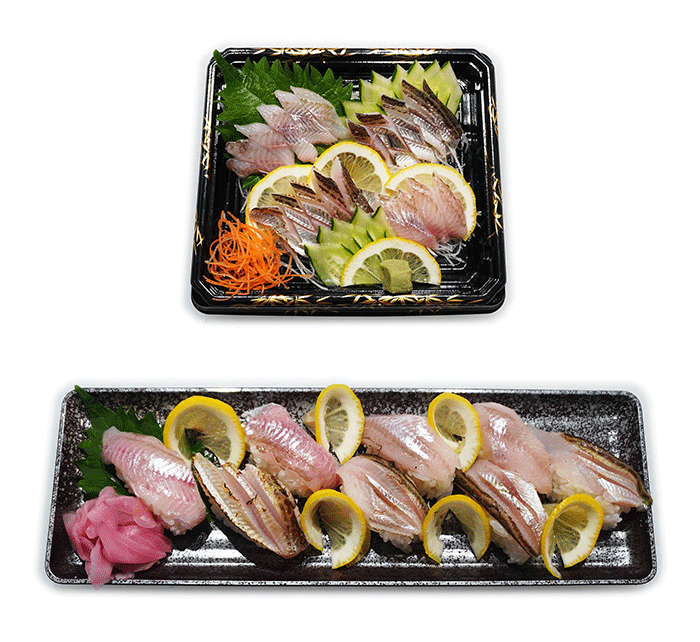
Sandfish sashimi & nigiri sushi
Season of sandfish
Season of sandfish came this year.
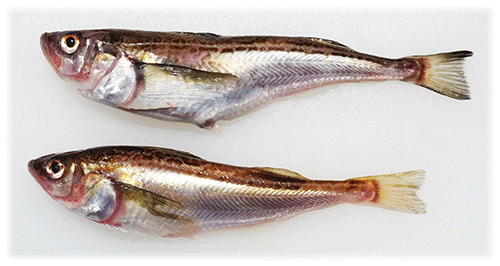
The top is female and the bottom is male, and the price is about twice that of males. The reason is that the fish eggs held by females called Brico in Akita are valuable.
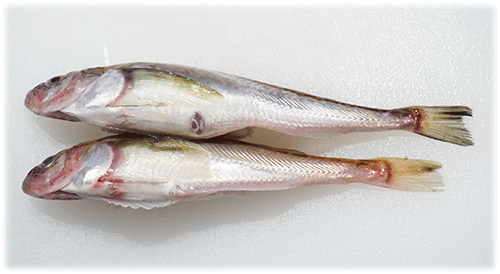
It is easy to distinguish between males and females, and the anus has a distinctly different shape as shown in the image above. Let's enlarge the image so that you can see it well.
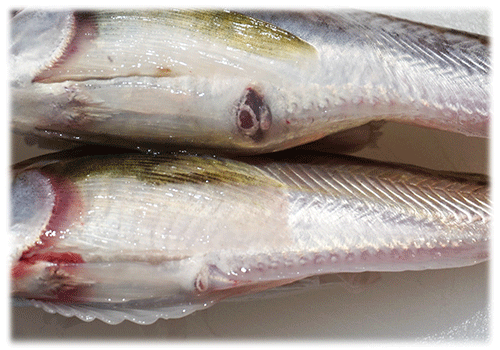
Female of the above are visible color close to purple Brico from the anus, because the male under visible whitish milt, the difference can determine anyone.
Burico
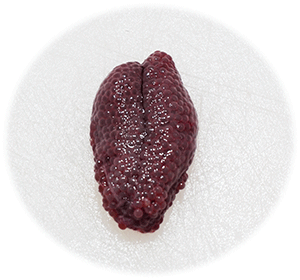
This is an egg of sandfish called brico, and when raw sandfish is grilled with salt, brico is a little hard but can be eaten with a crispy puchi puchi texture. However, when you eat sagohachi pickles, the hardness increases, and it becomes chewy like buchi buchi instead of puchi puchi. According to the people of Akita, it seems that such hardening is expressed as buri buri, which is why it became the name of brico.
By the way, this is one of the products sold as pickled sagohachi.
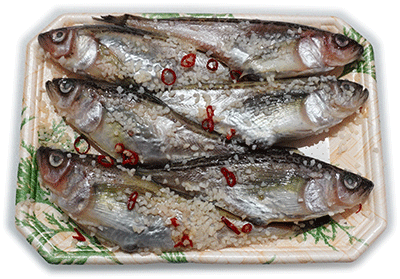
The interesting name Sagohachi seems to come from pickling salt, malt, and rice in a 3: 5: 8 ratio. When eating sagohachi pickles with brico, brico has a presence as if it were eating eggs rather than the body with less water as shown in the image below.

In sandfish holding brico, fish eggs are particularly conspicuous in this way. For example, if you put a knife in abdomen to remove the internal organs to grill sandfish with salt, it is inconvenient because the brico may pop out from the abdomen. In order to avoid that, there is a way to take out the internal organs without using a kitchen knife, so let me introduce it.
It is a method called tubonuki.
| How to work with tubonuki | |
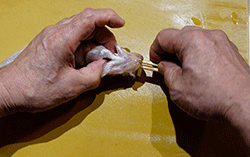 |
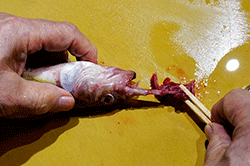 |
| 1,Open the gills lid with your left hand so that you can see the gills, spread the disposable chopsticks a little and grab the gills. | 4,Move slowly so that the internal organs are not cut. |
 |
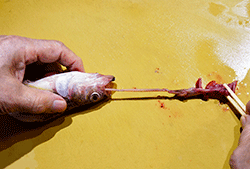 |
| 2,Grab the gills without breaking the disposable chopsticks and drag them out little by little. | 5,Pull out the internal organs to the end. |
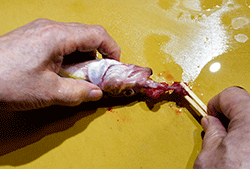 |
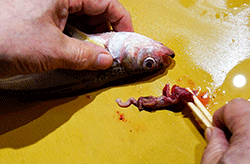 |
| 3,Grasp the gills firmly and pull them out of the fish's mouth. | 6,The state where tubonuki is finished. |
If you do this tubonuki, the brico will not be damaged as it is, it will not go out of the abdomen, and you can grill it with salt while it is still inside the abdomen.
It is said that males without brico are usually traded at about half the price of females, and of course males do not need tubonuki work and it is better to open the abdomen with a kitchen knife and cook. And, for example, in the case of fried food, the bones are soft, so you can eat up to the bones without necessarily fried twice.
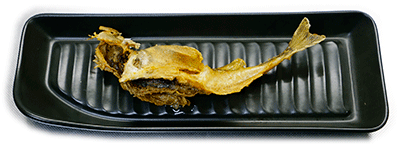
Akita preserved food
The area where sandfish inhabit is Tottori prefecture in the west, and the northern area from Hokkaido to the Kamchatka Peninsula in the north. For a very short period from the latter half of November to December, they approach the seagrass beds in shallow water near the sea and spawn all at once. And since there is a lot of catch at once at the timing when the sandfish, which is not usually seen at all, gathers intensively at this time, in the Akita region, these have been processed into various shapes and used as preserved food in winter. .. As a result of repeating such things for a long time, it seems that Akita's unique local cuisine using various sandfish was born. The above-mentioned pickled sagohachi is one of them, and among those preserved foods, the position like the prefectural food of Akita prefecture is "Hatahata sushi" in the image below.
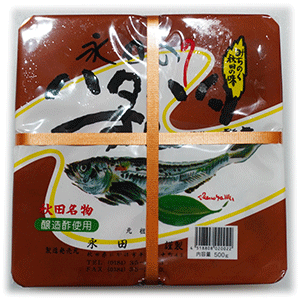
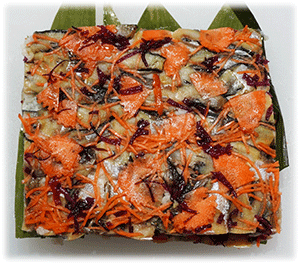
This is Hatahata sushi with 500g for 2,300 yen purchased at Akita Citizen's Market. When checking the contents, in addition to rice and malt, carrots, turnips, kelp, etc. are cut and included. It is divided into two stages by several leaf of kumasasa. The thickness of one step is not so thick, and you can clearly imagine it just by seeing that it is made by putting a weight on it and soaking it for about a month. This is a kind of "naresushi" by old-fashioned lactic acid fermentation similar to funasushi in Kansai.
It seems that Hatahata sushi is called "whole sushi" that leaves one fish, but this product is called "cut sushi" that weighs 500g. It seems that it is supposed to be cut and eaten as follows.
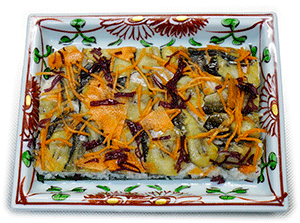
Far away in search of fresh sandfish ...
I visited Aomori in October, and next November I visited Akita in the neighboring prefecture to take action for the December issue of FISH FOOD TIMES. The purpose was to purchase fresh raw sandfish and its related products, which will be in season in December.
The author, who lives in Fukuoka, has eaten sandfish in the past, but it is a male whole dried fish sold at the 100% salt drying shop, and I never had the opportunity to eat raw females with brico. .. I had no experience of eating sandfish, which is especially fresh and can be made into sashimi or sushi, so I was wondering if that could be achieved someday. Then, just a little while ago, in late November, I suddenly thought about it and took action to turn sandfish into sashimi and sushi. It was three days after returning from Okinawa, and it was a round-trip bullet trip alone on a day trip to Akita.
I stayed in Akita for only 5 hours. At 7:30 in the morning, I took an airplane from Fukuoka to Haneda and arrived at Aomori via Haneda at 12:00. And it was 21:30 on the day that I returned to Fukuoka Airport via Haneda from Aomori Airport at 17:00, so the total round-trip time was 9 hours. The total purchase price of sandfish and related products is 10,000 yen and thousands of yen, but the cost of round-trip travel is not several times higher, so the cost of creating this month's issue is quite high.
And I was able to visit only these two places in Akita.
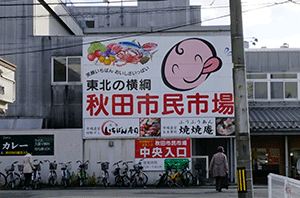
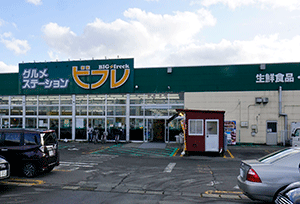
I bought all the products related to sandfish at Akita Citizen's Market, but I regretted that raw sandfish was sold at a price that was more than 30% cheaper than that at the local supermarket called Bifure in the upper right image. However, since the fish shop in Akita Citizen's Market is sold face-to-face, I was given various knowledge from the shop owner, and I was convinced that it was good.
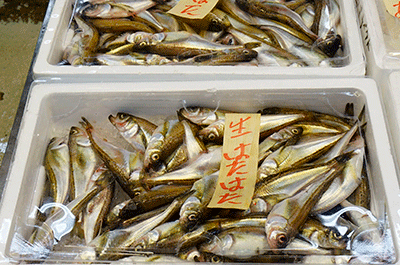
At the fishmongers in the market, raw sandfish were sold without displaying the selling price in this way. Although it was preserved with only ice underneath, I felt that it was fresher than other stores, so I decided to purchase it at this store. This store seemed to be a business style where the selling price was set by looking at the appearance and behavior of the customers. I felt that the price seemed to be a little higher because the owner could easily find out that he was a non-local single customer. However, regardless of that, the author relentlessly asked him various questions, and I think that it was worth the investment.
Anyway, the purpose was to "take the fresh sandfish that can be made into sashimi back to Fukuoka, take a picture, and eat it", so I decided that I didn't have to worry about whether the sandfish was expensive or cheap.
Cooking sandfish with a high level of freshness
From the morning of the next day, I started to make sashimi and sushi from the fresh sandfish that I got in this way, which is calculated on the third day after landing. I ate the nigiri sushi at lunch, sashimi at dinner, grilled with salt, and fried chicken, and ate all 10 females and 5 males I bought.
Females are lined up on the left side of the image below, and males are on the right side. Both males and females were given priority in choosing the largest size possible, but as you can see, the females were relatively large and the males were smaller. In this regard, according to the shop owner, sandfish generally tend to be larger for females. The latter half of November is "hashiri" when it comes to sandfish, and the female brico is not big enough, so the abdomen is about this size, but from now on, the abdomen will be It seems to swell and grow.
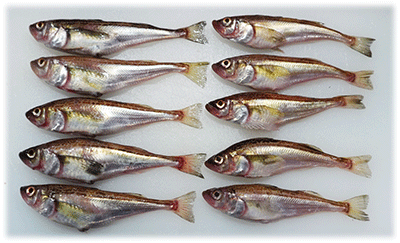
However, even if the abdomen grows, the length of the fish is no more than 20 cm. Because of this, it is difficult to cook because of its small size, so it seems that it has not been used much for sashimi in Akita. For the same reason, Hatahata sushi, which is a type of aged sushi, has existed for a long time, but it seems that it is rarely used for sushidane of Edomae sushi, which is premised on raw fish. It seems that Akita basically does not have the idea of "eating raw sandfish".
In addition, it is said that one of the reasons for not eating sandfish is that it is "prone to putrefaction". However, as far as I dealt with sandfis for 2 days, I didn't feel that the speed of freshness deterioration was so fast, and I thought that if I knew how to handle blue fish such as sardines and mackerel, I could manage the freshness sufficiently.
In other words, all you have to do is overcome the complexity of cooking small fish. Therefore, the author decided that the method of "three pieces disassembling with a head cooked with a yanagiba knife", which is used when cooking small horse mackerel, would be a good way to make sandfish into sashimi and sushidane.
| Sandfish three pieces disassembling work process with head | |
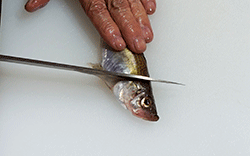 |
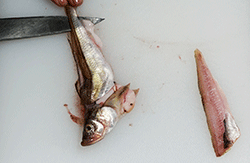 |
| 1,Make a notch with the cutting edge next to the lower body pectoral fin. | 6,Cut towards the caudal fin. |
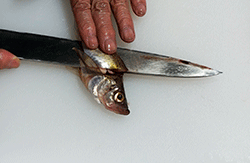 |
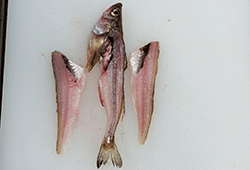 |
| 2Turn the cutting edge toward the tail and change the direction to an L shape. | 7,The head and central bone remained connected, and it became three pieces. |
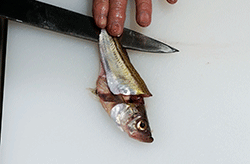 |
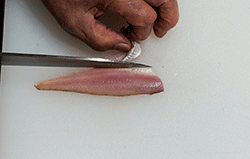 |
| 3,Continue to cut toward the tail. | 8,Remove the belly bone on the lower body side. |
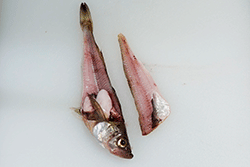 |
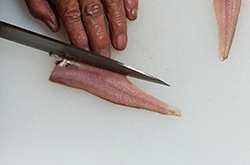 |
| 4,The state where the lower body is separated. | 9,Remove the belly bone on the upper body side. |
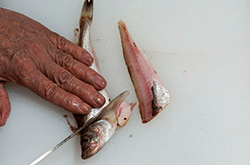 |
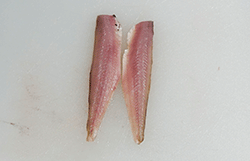 |
| 5,Make a notch with the cutting edge next to the upper body pectoral fin. | 10、Three pieces disassembled upper and lower body. |
Sandfish nigiri sushi and hiratsukuri sashimi
By doing the above, it is possible to disassemble three pieces in a short time even if the sandfish is less than 20 cm. Since sandfish has no scales, the cutting board is hard to get dirty, and there is no washing work to remove scales, so the work is easier than horse mackerel. If I take advantage of this feature of no scales, I thought that it would be possible to make a change by seared skin instead of removing all the skin when making sashimi or sushi. Then, the sashimi and sushi of sandfish were commercialized by the following process.
| Sandfish sashimi and nigiri sushi commercialization process | |
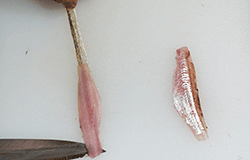 |
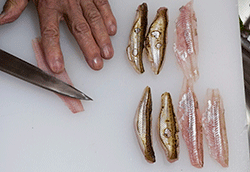 |
| 1,Half of the material used removes the skin. | 6,Cut in half diagonally for sushi without skin. |
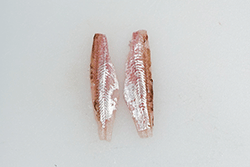 |
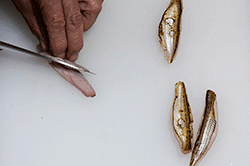 |
| 2,Since the skin is a small fish, the uchibiki method is easy. | 7,Also cut for seared sushidane in half diagonally. |
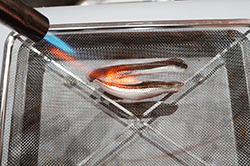 |
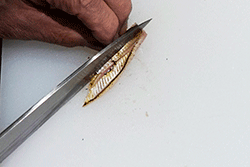 |
| 3,Half of the material seared the skin. | 8,Searing for sashimi is a decorative knife with half body. |
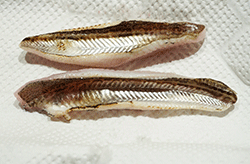 |
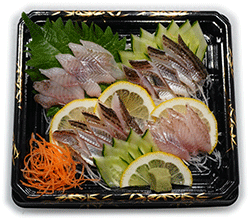 |
| 4,When searing is used, the skin is greatly curved. | 9,Two half-body sandfish hiratsukuri sashimi |
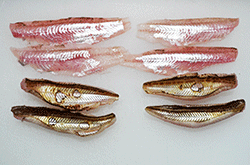 |
 |
| 5,4 sandfish with removed fish skin and searing. | 10,Sandfish nigiri sushi with 3 cans without skin and 3 cans with seared |
Let's eat sandfish raw with sashimi and sushi
In this way, I made sandfish sashimi and nigiri sushi and ate it to my heart's content. However, the taste of fat, which is the source of the umami of fish, was hardly felt, and the aftertaste was really refreshing. Which isn't surprising, sandfish live in the deep sea offshore for 11 months of the year, and approach the shallow water near the coast to spawn in seagrass beds for the purpose of spawning only for one month around December. Therefore, sandfish at this time should pass most of the nutrients of the fat stored in the fish to eggs and milts, and the fat is almost gone.
Actually, I found that the fish shop in Akita Citizen's Market where I bought sandfish also sells the fresh blackthroat seaperch as shown in the image below. Then, I bought one blackthroat seaperch on impulse, which I had never planned, and brought it back to Fukuoka to make sushi at the same time as sandfish.
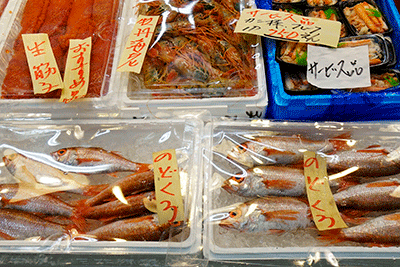
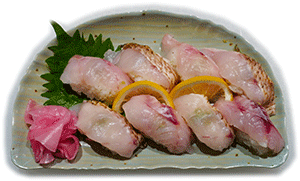
| blackthroat seaperch nigirisushi |
The "taste competition", in which sandfish and blackthroat seaperch are eaten and compared at the same time, was a really interesting experience for me because of the extreme difference in taste. In a sense, it was quite natural that the deliciousness of the blackthroat seaperch was emphasized, and it made me wonder which one was the main character.
However, the deliciousness of fish is not necessarily the deliciousness of fat, but there must be other ways of tasting it. There is no doubt that the blackthroat seaperch is so fat that it is called white toro and you can enjoy the highest quality umami that everyone will appreciate. On the other hand, sandfish at this time is in season but has almost no fat and has a refreshing taste, but it does not mean that it leads to unpleasant taste as it is, so it should be regarded as a unique taste of sandfish.
Since ancient times, the people of Akita have made full use of the sandfish caught in large quantities over a certain period of time and devised ways to eat it without wasting it, so there is a historical background that a unique food culture related to sandfish was born. After all, it was said that there was a time when the catch of sandfish exceeded 20,000 tons in the past, but now the quota for sandfish in Akita in 2019 was only 650 tons. And the price has changed from the old popular price of next to nothing to a high-class fish that costs 3,000 yen / kg.
Considering such changes in the times, the way of eating sandfish should change to a different form from the past. As an example of this, I think there is an option to "eat sandfish raw with sashimi or nigiri sushi" as in this month's issue. If it is positioned as a special existence for a limited period of time, the value of sandfish will be even higher than it is now.
| Please access the following URL if you want to secure using SSL. All pages in the site will be secure pages. |
| https://secure02.blue.shared-server.net/www.fish-food.co.jp/message english 12.2020.html |
An opinion and the communication are to iinfo@fish food times
Date of updating 1 Dec. 2020
